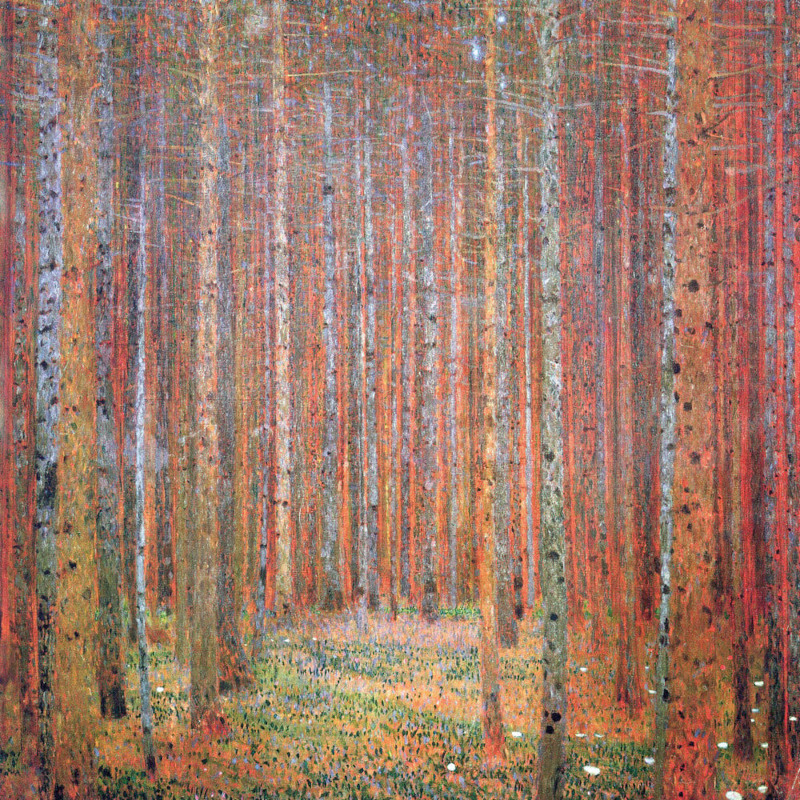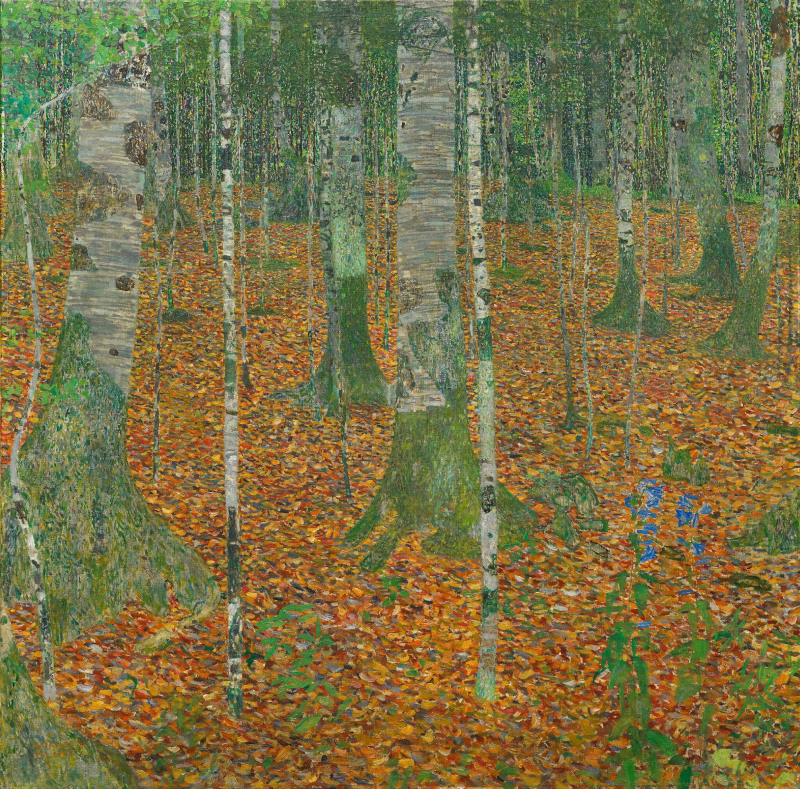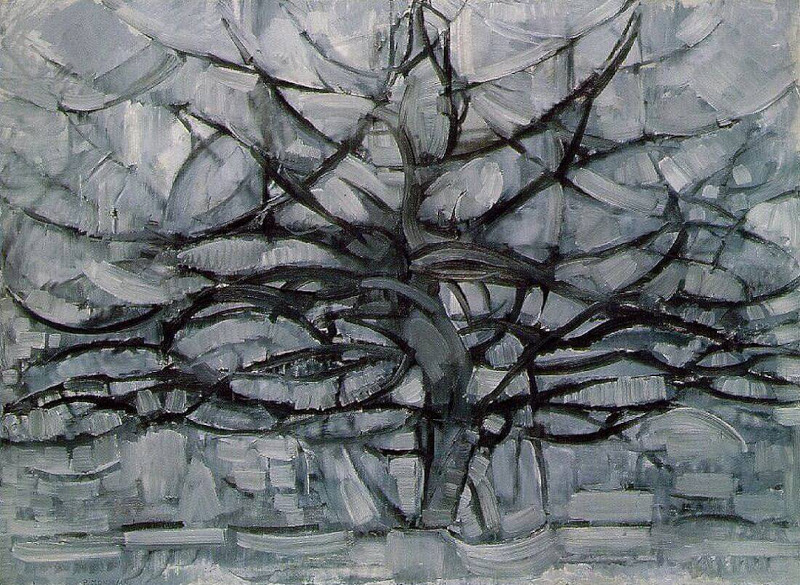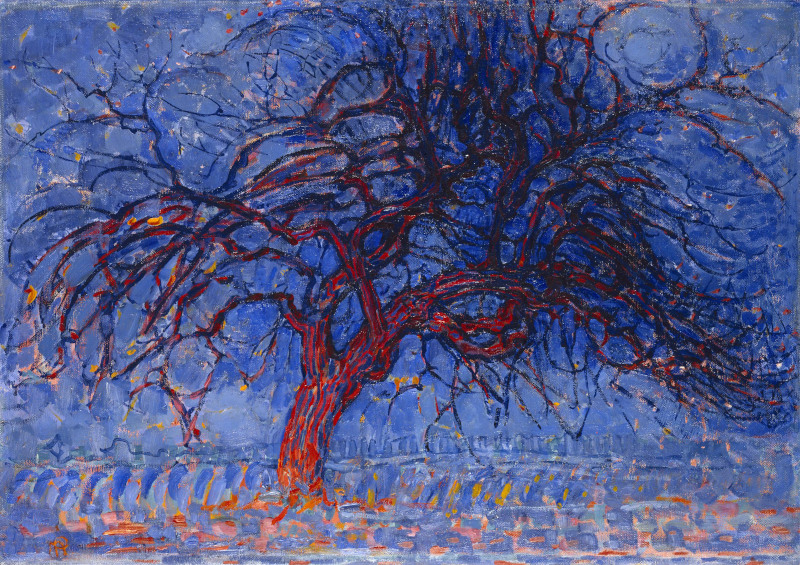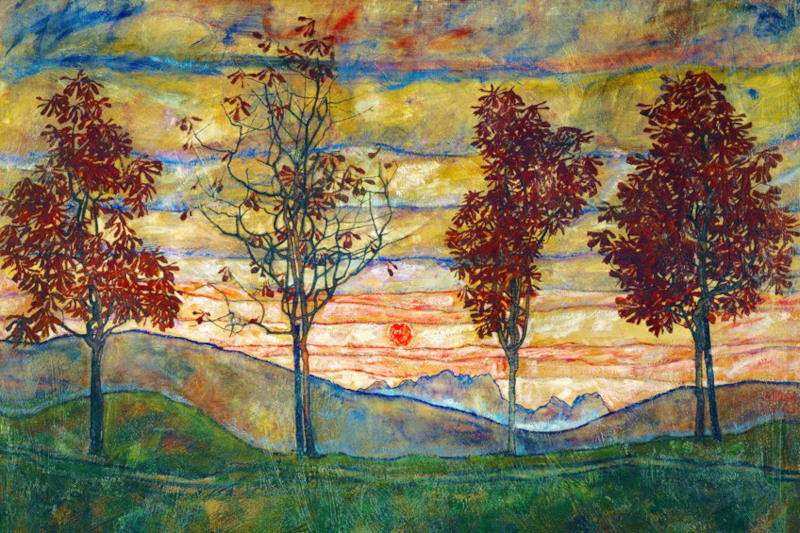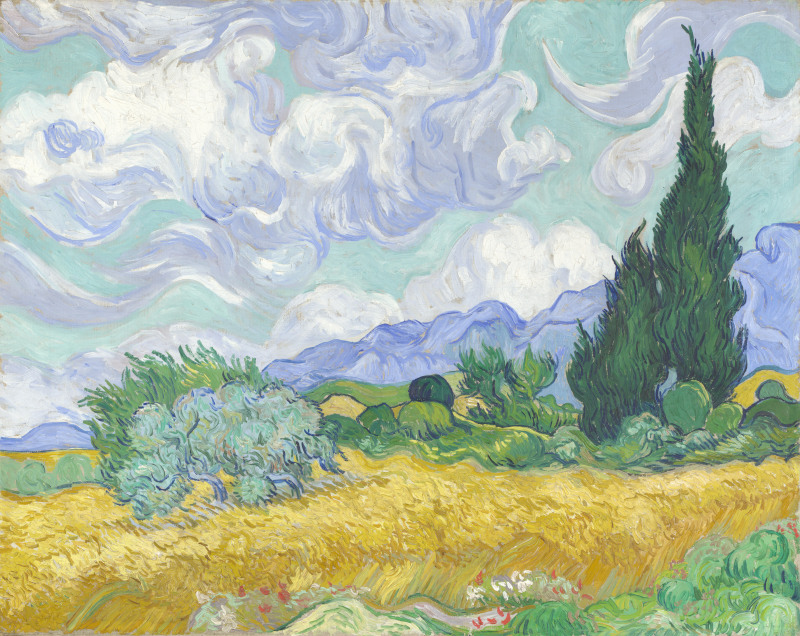Tree Paintings: Discovering the Timeless Beauty of Nature's Canvases
This article covers tree paintings in full, displaying many of the most famous tree paintings in western art, as well as discussing the different artists that have produced drawings, sculptures and paintings of trees over the past few centuries.
We feature a gallery of artworks below, listing the best paintings that we could find, and also discuss the history of trees in art, and how they can convey different meanings in different contexts. You will notice a variety of tree types in this list, including oak, pine, cypress and many others.
A List of Famous Tree Paintings and the Artists behind them
We have collated below a full list of famous paintings which feature trees in one guise or another. We have aimed to feature a variety of artists and styles, in order to indicate the many varied ways in which this popular plant has been used in art over the past few centuries.
The Tree of Life by Gustav Klimt
This stunning artwork features Gustav Klimt's use of gold leaf paint and captures swirling branches in a beautiful painting. It was a section of a mural known as the Stocklet Frieze but is treated by some as an independent work in its own right.
Notice in Tree of Life of how the artist flattens the perspective and is not interested in depicting reality, even though some of Klimt's other tree paintings are much more realistic. He was a versatile artist who sat within the Vienna Secession movement, an offshoot of the charming Art Nouveau era.
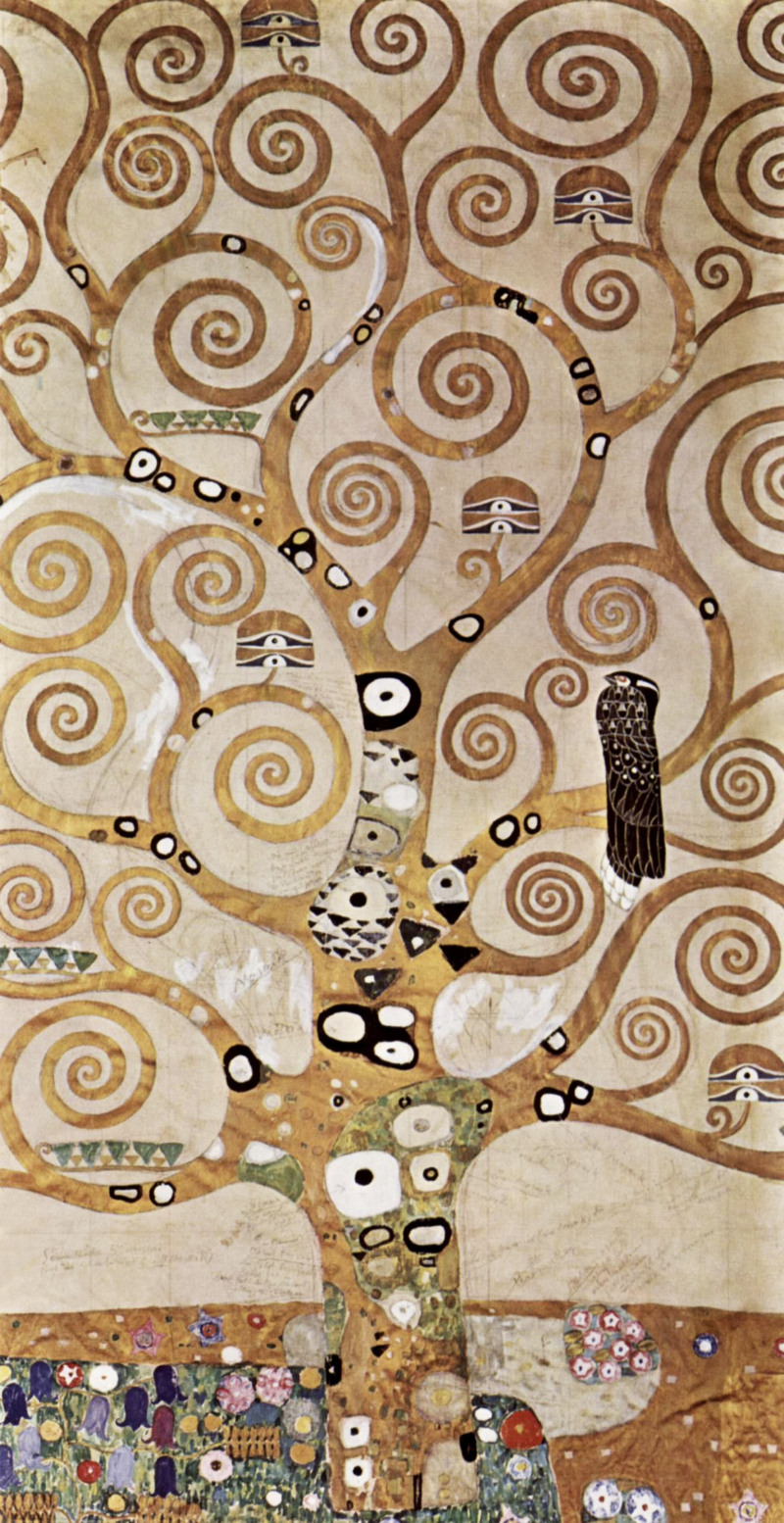 The Tree of Life by Gustav Klimt
The Tree of Life by Gustav Klimt
Birch Forest by Gustav Klimt
Birch Forest captures the tall narrow nature of these beautiful trees, with Klimt combining slimmer, younger trees alongside thicker, mature plants in the same composition. Notice how the artist composes this piece, cropping a seemingly random section of a forest, without anything close by to bring perspective.
One could almost term this a pattern, with no clear start or end point. Klimt produced many tree paintings in this manner, clearly appreciating these long, thin trees and how they contrasted with the fallen leaves that lay below.
The Oak Tree in the Snow by Caspar David Friedrich
Friedrich was a highly gifted Romanticism artist who focused on landscapes. Many of his artworks were sombre, and in this example he chose to capture a decaying tree, drawing on negative symbolism. The tree is unhealthy, suffering in the cold, just as humans might do without the necessary shelter.
Friedrich was one of the finest German painters, and also added human figures into some of his landscape scenes to create a sense of size and perspective. He covered trees many times, and was rare in devoting entire artworks to a single tree, particularly considering their poor condition, in some cases.
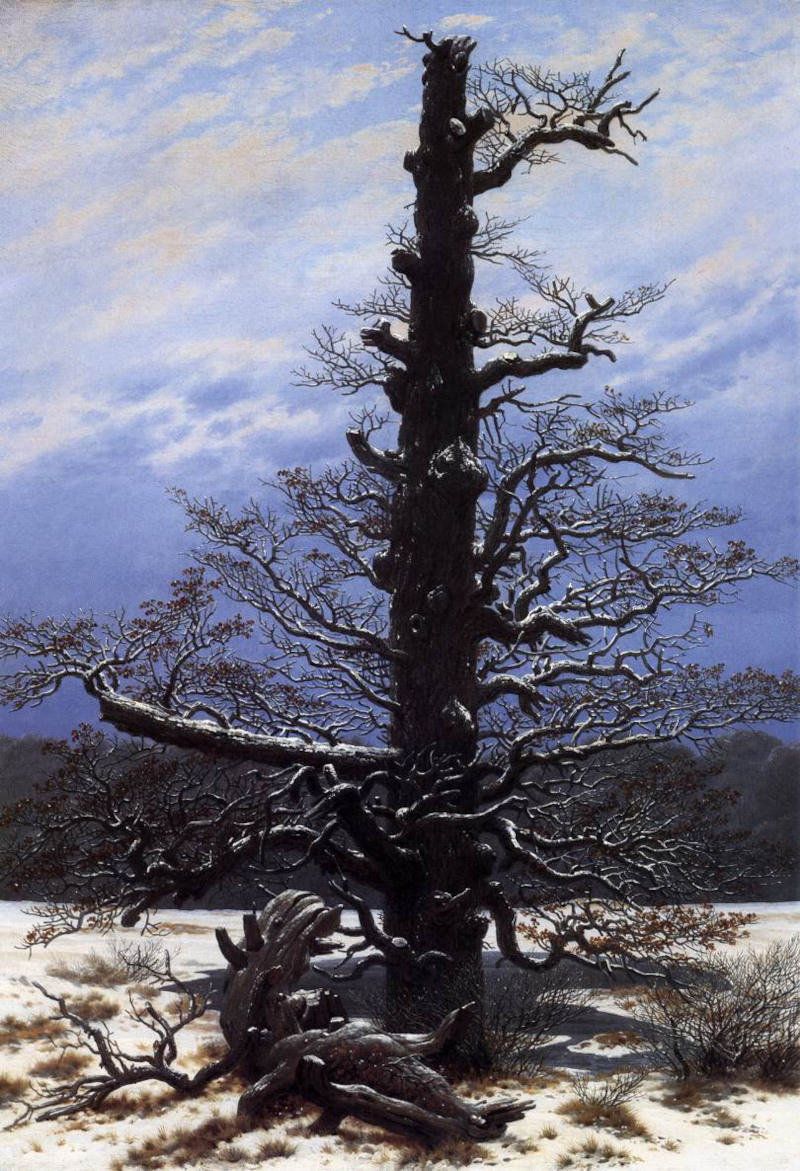 The Oak Tree in the Snow by Caspar David Friedrich
The Oak Tree in the Snow by Caspar David Friedrich
Cross in the Mountains by Caspar David Friedrich
Friedrich uses trees to lead the eye in this example, as they line a hill which converged in the centre of the painting. The artist regularly used crosses within his scene, to provide symbolic meaning for religion, without the need to add humanity into each artwork.
Cross in the Mountains makes use of a darkened tone which creates a particular mood, whilst also allowing the bright beams of light from the background to contrast strongly. This piece remains amongst his best known works, and perfectly captures the essence of this painter.
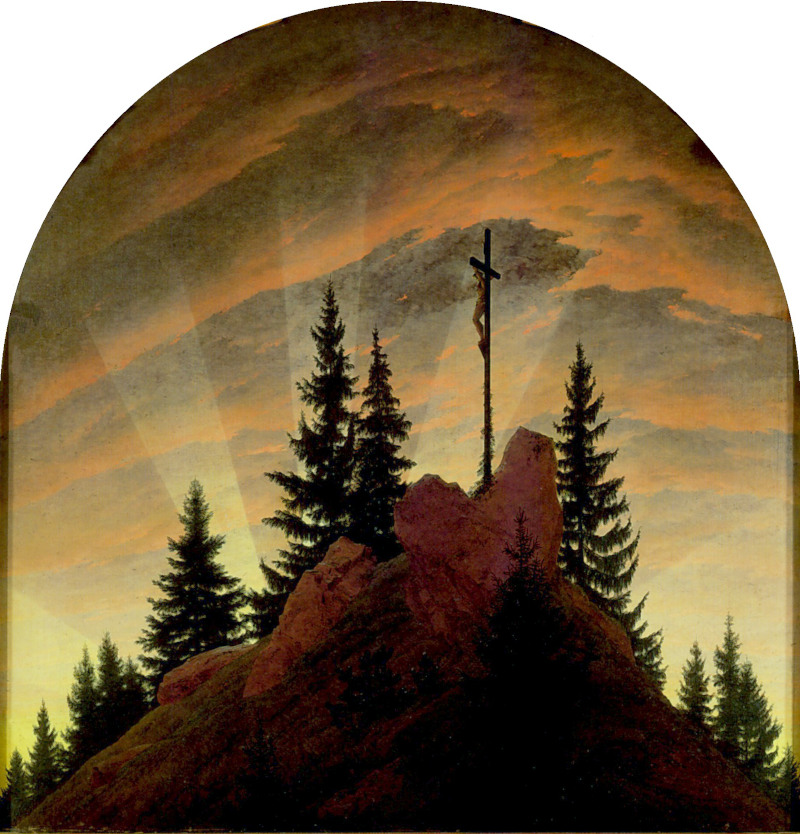 Cross in the Mountains - Tree Painting
Cross in the Mountains - Tree Painting
Chalk Cliffs on Rugen by Caspar David Friedrich
Chalk Cliffs on Rugen features a careful composition, in which the artist uses over hanging branches to form something of a window, through which we can observe the scenery in the distance. It is almost akin to a framed artwork, and very precisely leads the viewer's eyes.
As a further point of interest, several figures are added in the foreground, and we are essentially viewing what they are seeing at the same time, allowing us to get into their minds just for a short moment. The artist continued this in his Wanderer painting.
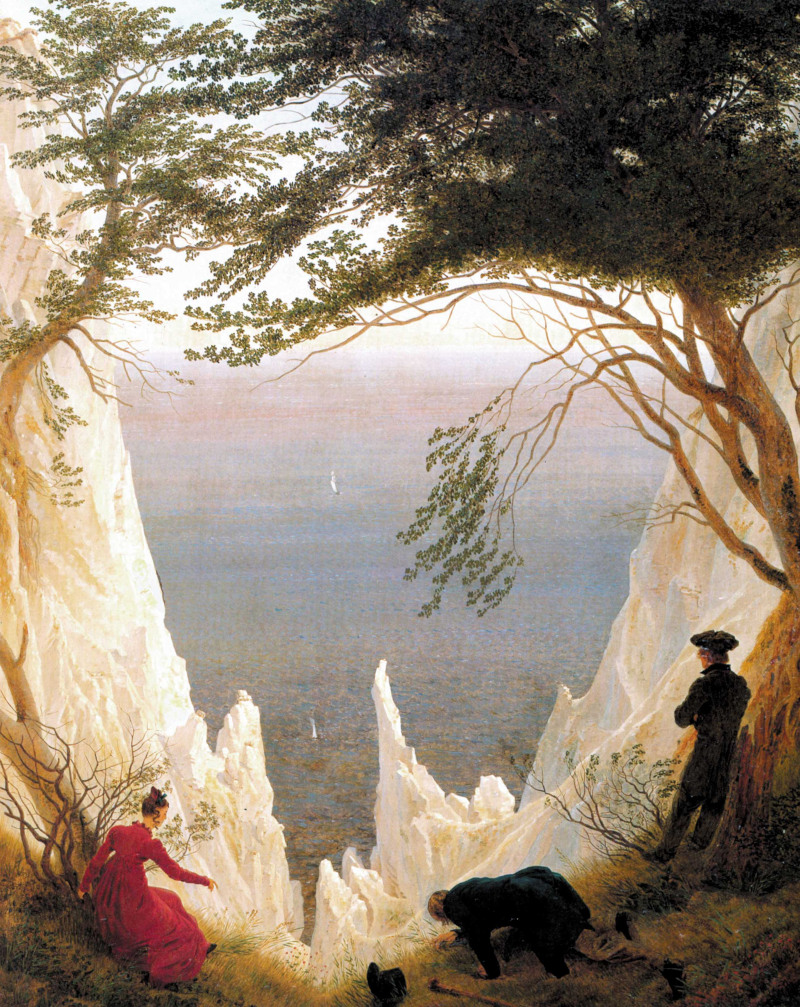 Chalk Cliffs on Rugen - Tree Painting
Chalk Cliffs on Rugen - Tree Painting
The Mulberry Tree by Vincent van Gogh
Mulberry Tree is a bright and expressive tree painting, with golden branches clashing against the bright blue sky that lies in the background. A simple stretch of blue signifies the shadow cast by the tree, though little shade is needed in this incredibly warm artwork.
The branches of the tree are swirling, connecting to the expressive nature of Van Gogh's work. Some outlines are added in black paint in order to help discern the edges of the plant, with vertical strokes used for the dark brown trunk.
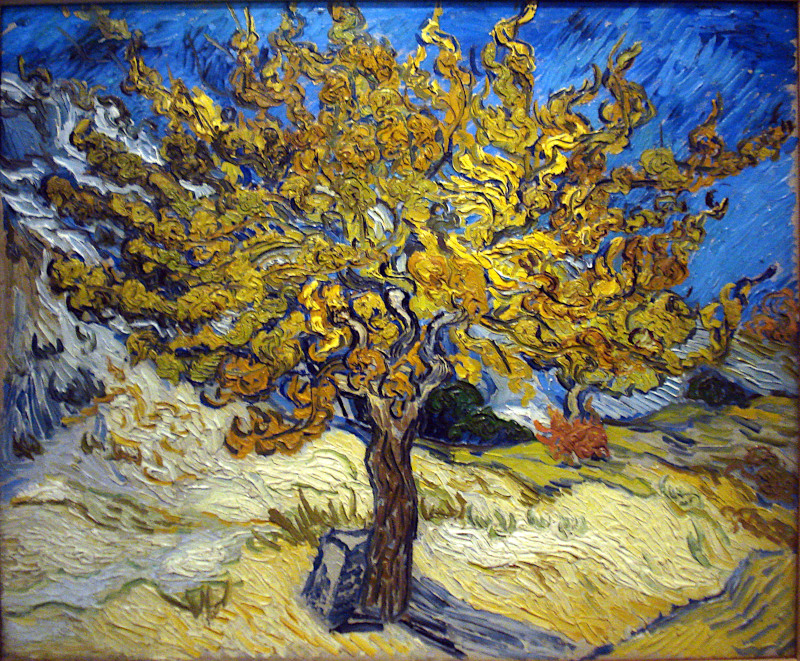 The Mulberry Tree by Vincent van Gogh
The Mulberry Tree by Vincent van Gogh
The Olive Trees by Vincent van Gogh
The swirling brilliance of Van Gogh returns again in Olive Trees. These short plants only reach up to the mid-way point of the painting and above we find swirling clouds, a signature of the artist, plus also dark blue tones that represent a rocky hillside in the distance.
The expressive nature of the artist allows the entire composition to merge together into a dream-like form, representing the original image only loosely. Van Gogh mastered trees and made them exciting by incorporating emotion into each depiction.
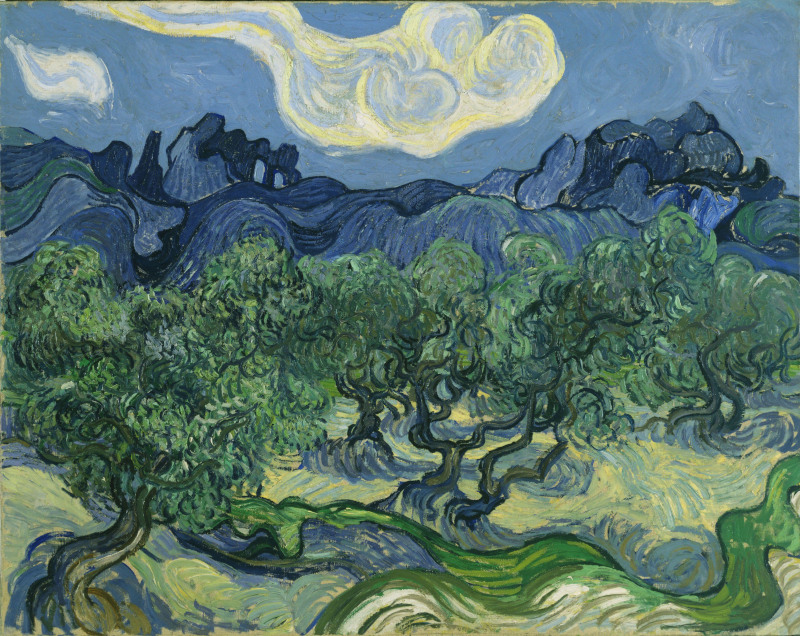 The Olive Trees by Vincent van Gogh
The Olive Trees by Vincent van Gogh
The Starry Night by Vincent van Gogh
Van Gogh used the cypress tree within his classic artwork, Starry Night. It was to symbolise immortality, but was also useful in providing a vertical structure in the foreground. It relation to the small town behind, the tree towers into the air.
Vincent uses vertical strokes of paint, darkened, for the main tree. In the distance we find curved, circular formations which are presumably smaller trees which are placed around the town to break up the architecture of the homes. Together they produce something of a sea wave appearance.
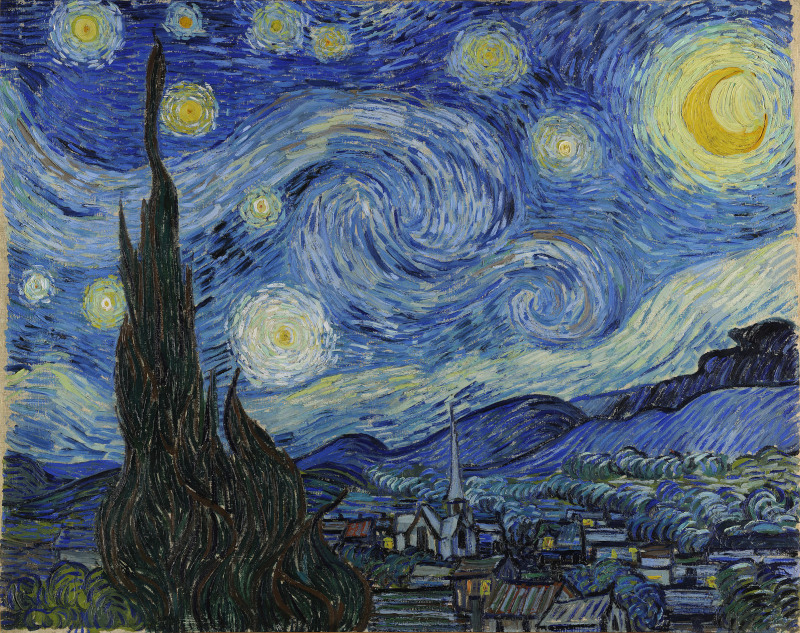 The Starry Night by Vincent van Gogh
The Starry Night by Vincent van Gogh
Gray Tree by Piet Mondrian
Piet Mondrian started to develop a less-traditional artistic style through a series of tree paintings. He would reduce these beautiful plants down to a series of strokes of paint, leaving individual brushstrokes still visible on the canvas. Gray Tree is perhaps the best of these, and gives an unforgettable atmosphere.
The artist also produced a series of landscape paintings with an abstract feel whilst travelling on local islands in the Netherlands. He loved the fresh sea air, and the complete tranquility of these quiet, almost uninhabited locations.
Evening, Red Tree by Piet Mondrian
Evening, Red Tree is a further addition to the tree series by Mondrian, adding some bright colors which deliver a completely different mood to this piece. Individuals touches of paint are still visible, and despite the darkened branches, its trunk is bright, making the tree look relatively healthy.
In the very background, perhaps a small bridge is visible. His tree series was not well known during Mondrian's lifetime, but in recent years has proven to be a popular section of his oeuvre, and it also represents the start of his transition towards abstraction.
Four Trees by Egon Schiele
Perhaps the finest tree painting of them all, Egon Schiele's Four Trees is a breathtaking Expressionist artwork. The use of color is key here, as well as the primitive manner in which the elements are delivered, almost recreating a child painting at school for the first time.
Schiele was a unique and truly gifted painter who helped to modernise techniques and incorporate emotion into art. He lines the trees up in a horizontal row, with a flat perspective almost akin to the art of the Middle Ages, though all of these tweaks are entirely intended, as Schiele could paint in a technically correct manner, if he chose to.
Almond Blossom by Vincent van Gogh
One of Van Gogh's finest paintings, this is one of a series devoted to almond trees, which he would have come across when living in France in the latter part of his life. The colors are particularly pleasant, and in this set he gets close in on the topic, where most of his tree paintings feature them as part of a wider landscape.
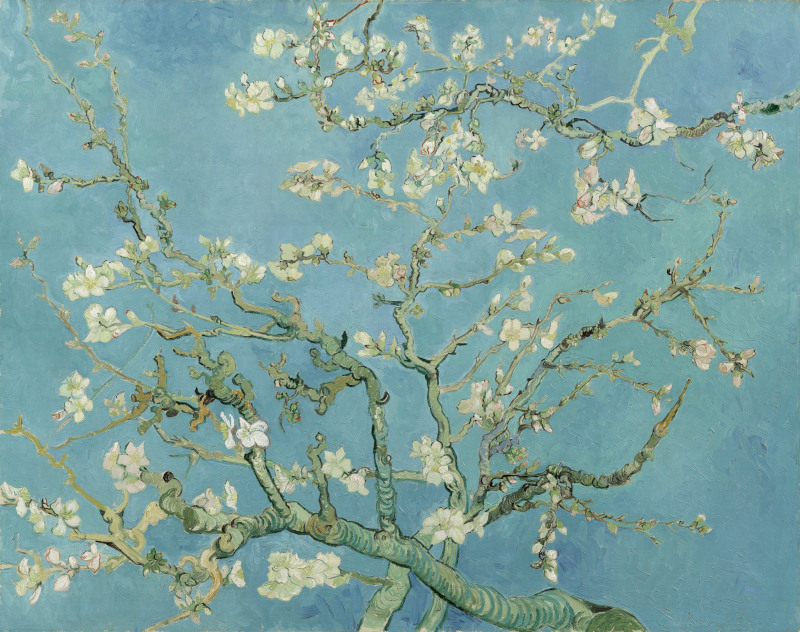 Almond Blossoms by Vincent van Gogh
Almond Blossoms by Vincent van Gogh
Wheat Field with Cypresses by Vincent van Gogh
The Hay Wain by John Constable
The British countryside is perfectly summarised by this famous John Constable painting known as The Hay Wain. Trees form a significant part of the landscape, and this artwork has something of a timeless quality to it. He specialised in landscape art and devoted his time to the county of Suffolk, rarely travelling beyond its boundaries.
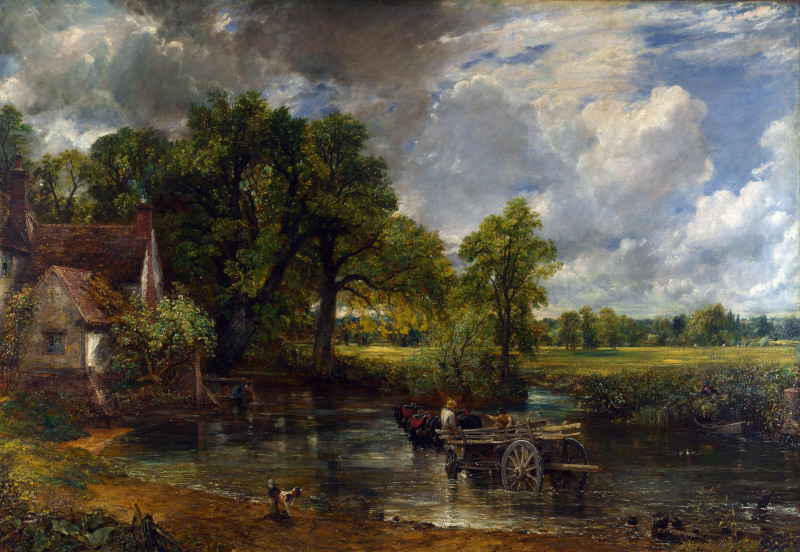 The Hay Wain by John Constable
The Hay Wain by John Constable
Mr and Mrs Andrews by Thomas Gainsborough
This addition may come as a surprise, but the thick trunk sitting behind the couple serves an important purpose within this famous Gainsborough painting. He could combine landscape art with portraiture, and achieved a number of impressive commissions because of his impressive technical skill that had been honed over a long period of study and practice.
British art has a history of covering its green and pleasant landscape. Trees have been a major part of that, with thick, strong trees decorating many parts of this beautiful island. Constable, Turner and Gainsborough have all incorporated landscape elements into their work, and even the Pre-Raphaelites would find ways to include it alongside their stunning figurative portraits, combined with themes of mythology and British literature, including poetry most significantly.
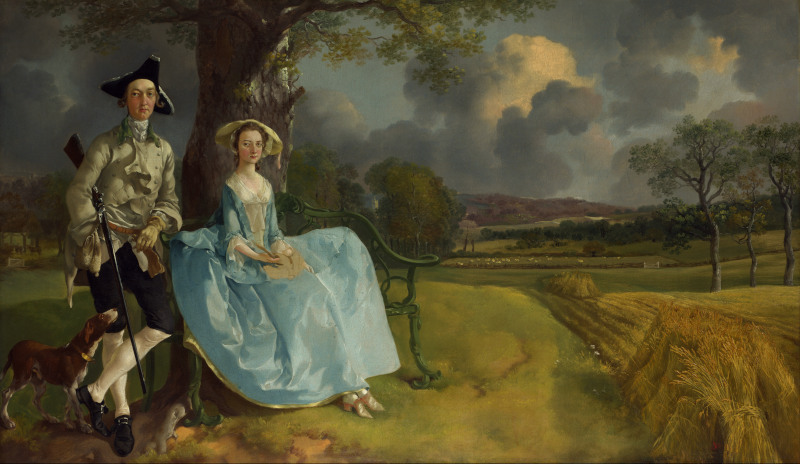 Mr and Mrs Andrews by Thomas Gainsborough
Mr and Mrs Andrews by Thomas Gainsborough
A Historical Journey: Tracing the Evolution of Tree Paintings
Trees have been used within art for many centuries, dating back to Egyptian and Mesopotamian times. Their symbolic meanings have been beneficial to artists, though different cultures have used trees to represent different ideas. Life, fertility, knowledge and salvation are just a few of the themes that trees have been used to represent.
Much of the Italian Renaissance was about precision and accuracy, reaching new levels never seen before. Artists within it, as well as from the Northern Renaissance, would therefore attempt to capture trees as precisely as possible through repetitive practice and also from careful observation.
Tree paintings then started to become more common within European art thanks to the rise in prominence of landscape painting. The Romanticists would use them to represent the beauty of nature more generally, before later artists started to create abstract forms of them in a more expressive manner.
Tree paintings have also been useful for representing a particular region, with many trees being found more commonly in some locations than others - one example would be the cypress trees found in Tuscany, or some of the British-based trees found in the work of Turner and Constable.
Techniques and Styles: Unleashing the Artistic Vision in Tree Paintings
The most radical aspect of tree painting is in the inclusion of elements of a tree within the art itself. Many will be familiar with trips to a primary school, where children are collecting leaves and branches, or perhaps a small piece of bark, and then attaching it to paper with glue.
Professional artists have even done similar, in a more nuanced manner. This helps to bring a connection between the art and its subject, but is not easy to do effectively. Alternatives include adding sand or stone to a painting.
In terms of more traditional art, artists will observe a tree in great detail, attempting to capture every aspect of it. This could be within the Romanticist or Renaissance eras. More recently, artists might use an expressive manner to give a broad impression of a tree, often with almost no detail whatsoever - in that case, the use of color can be critical.
Capturing Majesty: Composition and Perspective in Tree Paintings
Trees can be used to section out a painting, or even to lead the eye with a sweeping branch or careful arrangement of multiple trees. Tone can also be varied between the foreground, middle and background, or even by varying the types of trees included.
It is possible to create different moods from the angle in which a tree is viewed. When seen from below, an object will appear larger in comparison which can bring symbolic values with it. There can also be a different balance between large trees in the foreground, dwarfing everything else, or smaller trees dotted around in the distance.
Seasons on Canvas: Embracing Colors and Textures in Tree Depictions
The seasons bring varied palettes into landscape paintings, and trees can be greatily impacted by that. Impressionists displayed this the best, often capturing the same element right across the year, such as haystacks, plants and even buildings. The tones used would reflect nature itself, with colder tones for autumn and winter, and warmer tones for spring and summer.
Besides the climate, the colors would represent real elements such as snow, falling leaves, sunshine rays and deflections of light across water. The trees themselves would also look different, bare or filled with an abundance of life, weak or strong.
Contemporary Tree Paintings: An Insight into Modern Artistic Expressions
Abstract forms of trees have been prevalent since the days of Piet Mondrian and continue to appear today. He wanted to promote the beauty of his region, but without any deeper message than that. Nowadays, other artists may connect activism to their work, and give clear instructions on how humanity should best proceed.
Sculptures can also be set up in a manner in which the three dimensional aspect of trees are represented. This provides something with which we are all familiar, but then with an opportunity to provide a twist in some way. Conceptual art continues to evolve in this way, and attempts to make art as accessible and thought-provoking as possible.
Legendary Artists and their Arboreal Creations: Icons of Tree Painting
Whilst countless numbers of artists have included trees and other related plants within their paintings, drawings or sculptures at one point or another, there is a select list of artists who have become particularly famous for covering this topic.
These include the likes of Vincent van Gogh, Caspar David Friedrich, Paul Cezanne, Tom Thomson and Georgia O'Keeffe. Their approaches vary widely, depending on the type of mood that they were trying to convey.
How Trees have been used to Compose Paintings
Trees have brought advantages to artists when composing their paintings. With the different shapes brought about by the different types, artists can use them for all manner of requirements. The most obvious usage is to 'frame' a composition by running a tree vertically down one side of the painting, which helps the artist to lead the eye of the viewer.
Trees can also be used to produce interesting lighting effects, where light might partially show through branches, or cast a strong shadow over part of the painting. The also can be used to represent seasons, such as when bent in a strong wind, covered in snow, or perhaps with leaves in various stages of health.
Rows of trees can also be used to produce a sense of perspective, as they continue into the background, along a vanishing point. This follows a similar route taken by artists since the Renaissance with regards architectural design.
Types of Trees Popular with Artists
Trees offer a variety of meaning within art, depending on their size and structure. Some of the most popular trees for artists are oak, willow, cypress, poplar, birch and palm. Palm trees are perhaps the best for giving the impression of an exotic, sunny location.
Oak trees are seen as strong and commanding, symbolising strength and love term survival, but without the delicate nature of other species of tree. Willow trees are popular in Asian art, whilst cypresses and poplars can be found in south European art, including Claude Monet and also Van Gogh during his time in France.
The slim, vertical nature of the birch tree appealed to Gustav Klimt, who captured dense forests which filled the entire canvas. Much would depend on the trees available around each artist, though some would travel around in order to find landscapes that best suited their artistic style.
Healing Landscapes: The Therapeutic Benefits of Tree Paintings
Research has revealed that the calming effects on the human mind from nature can even be replicated by images of nature. For those unable to access rolling hills and grassy terrain, tree paintings may be the next best option. Benefits of connecting to nature include a calmer mind, increased positivity, a better ability to concentrate and contemplate, as well as improved creativity.
With regards tree paintings specifically, observing the seemingly infinite arrangements of branches can help us to reduce stress and reduce clutter from our minds, in a similar way to meditation. They also remind us of our inherent connection to nature, and the importance of regularly renewing that relationship.
From Branches to Brushstrokes: The Artistic Rendition of Trees
The painting of trees, and other related items, brings many technical challenges to artists. These can be handled with different artistic styles, meaning some challenges are more relevant than others. For example, those looking to work in a precise manner will need to study a tree in great detail, as well as in how it interacts with neighbouring elements, whilst a more expressive artist could potentially ignore much of that.
In terms of brushstrokes, an expressive artist might work in an approximate fashion, using thick strokes to create a mood. By comparison, someone sketching a detailed copy of reality might try to capture each branch at its correct angle. There can also be a use of contours and shading to make an image even more accurate.



